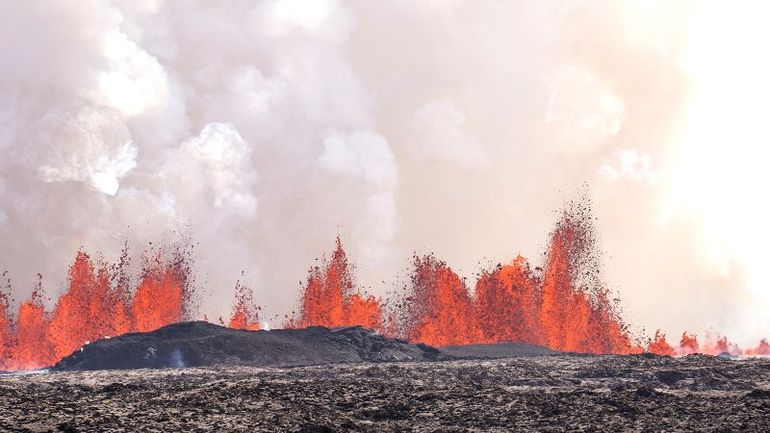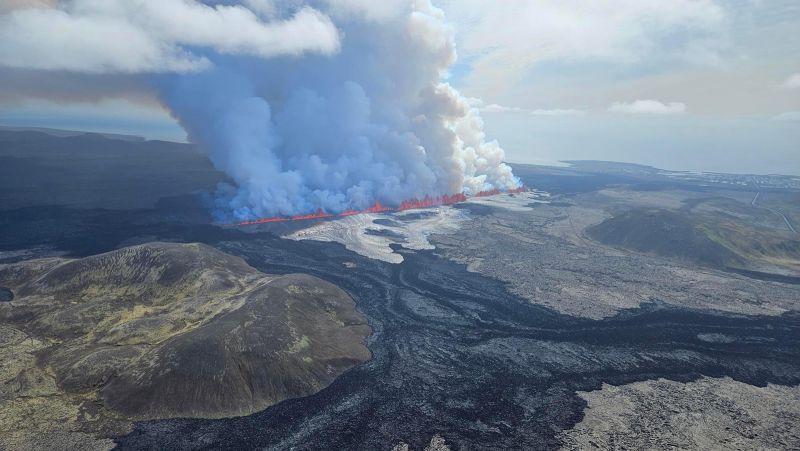
Iceland's Volcano Erupts Once More, Lava Nears Town's Protective Barriers

In a dramatic event, a volcano in southwestern Iceland has erupted once again, sending streams of lava towards the defensive walls of the town of Grindavík. This fifth eruption since December poses a significant threat to the area, leading to the evacuation of the renowned Blue Lagoon.
A volcano in southwestern Iceland erupted on Wednesday for the fifth time since December. It spewed massive lava flows that are now threatening to cut off the town of Grindavík. The eruption also led to the evacuation of the world-famous Blue Lagoon.
Dramatic videos and images captured from the scene showed fountains of red-hot lava shooting into the air. This happened along a 3.4-kilometer (two-mile) fissure near Mount Hagafell on the Reykjanes Peninsula.
Iceland’s Meteorological Office mentioned that scientists believe the beginning of this eruption is more powerful than previous ones in the area.
Icelandic Coast Guard
video
Related video
Watch lava flow from Iceland’s volcano… again
The eruption at the Sundhnúks crater in Iceland began on Wednesday around 1 p.m. local time after an earthquake, as reported by Iceland's public broadcaster RUV. The Met Office had previously issued a warning about the possibility of a volcanic eruption due to intense seismic activity at the crater and the accumulation of magma in its underground reservoir.
According to the Met Office, lava flows have blocked two of the three roads leading to the fishing town of Grindavík. The lava is also advancing towards a defensive barrier that was constructed to protect the town and essential infrastructure from potential destruction.
"Lava is currently flowing outside the defense walls in multiple locations at Grindavík, and there are also signs of lava starting to seep outside the walls at Svartsengi," Víðir Reynisson from Iceland’s Civil Defense informed RUV.
He cautioned that there is a possibility of Grindavík being completely isolated, but he reassured that the defense barriers are currently holding strong.
Reynisson reportedly said that the houses in the west and farthest part of the town would have been destroyed by lava if it wasn't for the defensive walls, but they are still standing strong.
Grindavík, a town with around 3,000 residents, was mostly evacuated before a previous eruption in December. Despite urging from authorities, three residents are refusing to leave, while others have been advised to evacuate while they still can.
Another volcanic eruption is seen from a helicopter flight for the fifth time since December on the Reykjanes peninsula in southwestern Iceland on May 29, 2024.
Another volcanic eruption is seen from a helicopter flight for the fifth time since December on the Reykjanes peninsula in southwestern Iceland on May 29, 2024.
Electricity was turned off in Grindavík on Wednesday as a precautionary measure. This was done because lava flows were getting closer to high-voltage lines and hot and cold pipes in the ground. Kristinn Harðarsonar, who is the production manager at energy company HS Orka, provided this information to RUV.
"According to Reynisson from the Civil Defense, many high-voltage lines have been destroyed and some pylons are even on fire."
Benedikt Ófeigsson from Iceland’s Met Office mentioned to RUV that the eruption's initial phase was stronger than expected because of the increased amount of magma in the chamber.
“It’s a lot more lava flow than we’ve seen before,” he reportedly said. “This is reflected in today’s massive lava flows.”
CNN
video
Related video
All 3,600 residents of this Icelandic town were evacuated. Hear why many won’t return
Iceland’s Ministry of Foreign Affairs reassured that international and domestic flights were not affected by any disruptions.
However, the Blue Lagoon, a popular geothermal spa and tourist destination in Iceland, was evacuated for the third time in a little over two months, as reported by its operations manager.
Just a short drive away from Reykjavik, Iceland's capital and largest city, the Blue Lagoon is a top tourist spot in the country. It is located on the Reykjanes Peninsula in southwest Iceland, which juts out into the North Atlantic Ocean from Reykjavik.
Iceland is known for being one of the most active volcanic regions in the world. Unlike other areas with a central volcano, the Reykjanes Peninsula is characterized by a rift valley, along with lava fields and cones.
Editor's P/S:
The relentless volcanic eruptions in Iceland paint a vivid picture of the Earth's raw and untamed power. The streams of molten lava, captured in dramatic footage, serve as a testament to the planet's geological forces that shape and reshape our world. The ongoing threat to Grindavík highlights the vulnerability of human settlements in the face of such natural phenomena.
While the destructive potential of these eruptions is undeniable, it is also important to recognize the scientific significance they hold. The increased intensity of the initial phase, as noted by experts, offers valuable insights into the dynamics of volcanic activity. Moreover, the ongoing monitoring and analysis of these eruptions contribute to our understanding of volcanic processes and their impact on the environment.









